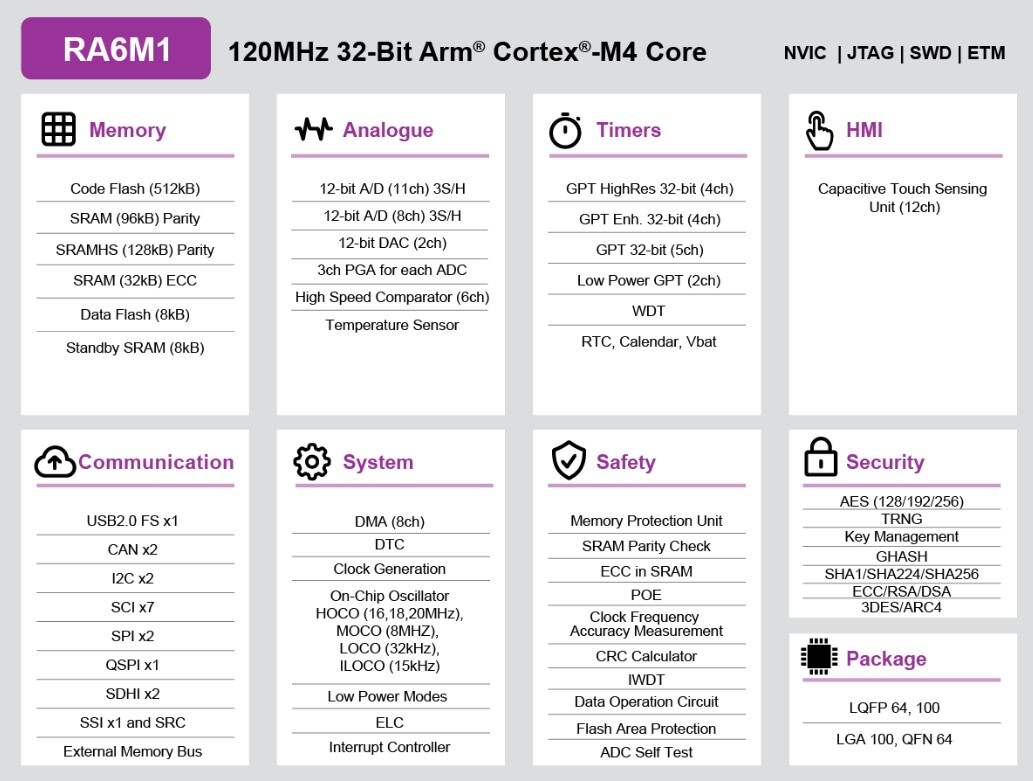RA6M1 Evaluation Kit
Overview
The Renesas RA6M1 microcontroller is the entry point to the Renesas RA6 product series for applications that require a high-performance Arm® Cortex®-M4 core at a very attractive price point. The RA6M1 is built on a highly efficient 40nm process and is supported by an open and flexible ecosystem concept—the Flexible Software Package (FSP), built on FreeRTOS—and is expandable to use other RTOSes and middleware. The RA6M1 is suitable for IoT applications requiring security, large embedded RAM and low power consumption.
The key features of the EK-RA6M1 board are categorized in three groups as follow:
MCU Native Pin Access - R7FA6M1AD3CFP - 100-pin LQFP package - 120 MHz Arm® Cortex®-M4 core with Floating Point Unit (FPU) - 256 KB SRAM - 512 KB code flash memory - 8 KB data flash memory
Connectivity - A Device USB connector for the Main MCU - S124 MCU-based SEGGER J-Link® On-Board interface for debugging and programming of the RA6M1 MCU. A 10-pin JTAG/SWD interface is also provided for connecting optional external debuggers and programmers. - Two PMOD connectors, allowing use of appropriate PMOD compliant peripheral plug-in modules for rapid prototyping - Pin headers for access to power and signals for the Main MCU
Multiple clock sources - Main MCU oscillator crystals, providing precision 12.000 MHz and 32,768 Hz external reference clocks - Additional low-precision clocks are available internal to the Main MCU
General purpose I/O ports - One jumper to allow measuring of Main MCU current - Copper jumpers on PCB bottom side for configuration and access to selected MCU signals Operating voltage - External 5 V input through the Debug USB connector supplies the on-board power regulator to power logic and interfaces on the board. External 5 V or 3.3 V may be also supplied through alternate locations on the board. - A two-color board status LED indicating availability of regulated power and connection status of the J-Link interface. - A red User LED, controlled by the Main MCU firmware - A User Push-Button switch, User Capacitive Touch Button sensor, and an optional User Potentiometer, all of which are controlled by the Main MCU firmware - MCU reset push-button switch - MCU boot configuration jumper
Special Feature Access
USB Full Speed Debug and Device (micro-AB connector)

EK-RA6M1 Board Functional Area Definitions (Credit: Renesas Electronics Corporation)
Hardware
Detailed hardware feature for the RA6M1 MCU group can be found at RA6M1 Group User’s Manual Hardware

RA6M1 Block diagram (Credit: Renesas Electronics Corporation)
Detailed hardware feature for the EK-RA6M1 MCU can be found at EK-RA6M1 - User’s Manual
Supported Features
The below features are currently supported on Zephyr OS for EK-RA6M1 board:
Interface |
Controller |
Driver/Component |
|---|---|---|
GPIO |
on-chip |
gpio |
MPU |
on-chip |
arch/arm |
NVIC |
on-chip |
arch/arm |
UART |
on-chip |
serial |
CLOCK |
on-chip |
clock control |
Other hardware features are currently not supported by the port.
Programming and Debugging
Applications for the ek_ra6m1 board target configuration can be
built, flashed, and debugged in the usual way. See
Building an Application and Run an Application for more details on
building and running.
Flashing
Program can be flashed to EK-RA6M1 via the on-board SEGGER J-Link debugger. SEGGER J-link’s drivers are avaialbe at https://www.segger.com/downloads/jlink/
To flash the program to board
Connect to J-Link OB via USB port to host PC
Make sure J-Link OB jumper is in default configuration as describe in EK-RA6M1 - User’s Manual
Execute west command
west flash -r jlink
Debugging
You can use Segger Ozone (Segger Ozone Download) for a visual debug interface
Once downloaded and installed, open Segger Ozone and configure the debug project like so:
Target Device: R7FA6M1AD
Target Interface: SWD
Target Interface Speed: 4 MHz
Host Interface: USB
Program File: <path/to/your/build/zephyr.elf>
Note: It’s verified that we can debug OK on Segger Ozone v3.30d so please use this or later version of Segger Ozone
